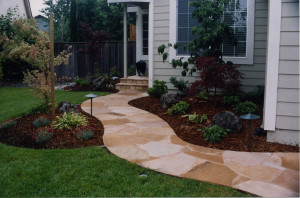Gardens typically have patios, gates, benches, vegetable boxes and the like, and we at Details Landscape Art like to connect the various elements of the garden with pathways.
Whether from the driveway to the front entry, or an entertaining area to the side gate, or from the back door out to a sitting area under an arbor, walkways are the veins and arteries of the landscape. Details is one of the premier design-build contractors in the North Bay, and we generally try to encourage homeowners to participate in their gardens rather than just look at them. We hope people will enjoy gardening, entertaining, pausing for a cocktail or a cup of coffee, or smelling the roses. Pathways facilitate movement from one area to another.

We build walkways using a variety of hardscape materials, and the choice is usually dependent on other hardscape materials chosen. We can certainly use the same material used for the patio. Or we can use a contrasting material, always being careful not to mix too many different materials in the same garden space. For example, two of our favorite walkway materials are flagstone steppingstones and decomposed granite.
Flagstone steppingstones offer more of an informal flavor than a hard poured concrete surface, and blends well with either a mortared flagstone patio or stamped concrete driveway or patio. We use large pieces, generally two to three feet wide, and one and a half to two inches thick for stability and to support an adult’s weight. We fit the pieces together with about a one-inch gap in between, and we love to make sweeping curves. We then set these pieces using compacted fill dirt or quarry finds. These are materials that pack down firmly, fill the small indentations and irregularities on the underside of the stone, and serve to make the steppingstones very stable and solid.

Decomposed granite is another less formal alternative – back east it’s called hardpan ,and in the dry summer months in Northern California it is quite firm and dry. It gets a little soft and mushy with the winter rains, and can get tracked into the house by people and by dogs. It can easily scratch hardwood floors. We can use a synthetic stabilizer material to bind the particles and make the surface firmer in the rainy season. See our separate blog about decomposed granite. Ground covers along the pathway edge that creep over the edge create a real soft Mediterranean feel.
We also build walkways using the same stamped concrete as on patios and driveways, for a more uniform look. Another walkway surface is flagstone mortared down onto a concrete base, shown in the photo below.
 Brick is yet another walkway option – or exposed aggregate with a brick border. The possibilities are endless.
Brick is yet another walkway option – or exposed aggregate with a brick border. The possibilities are endless.
But pathways are an essential part of garden design. In the absence of formal walkways, sure, people can walk on the bark in-between the plants and boulders, but then the bark gets kicked around and becomes unsightly. Better to have something solid to walk on.

